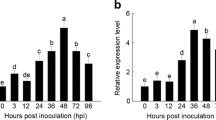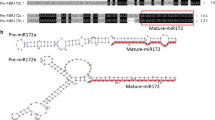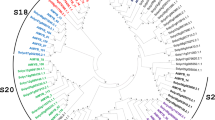Abstract
Proteinase inhibitors (PIs) play an important role in plant responses to biotic and environmental stimuli, but little is known about the role of PIs in mediating plant immune responses to microbial infection. In this study, a gene named proteinase inhibitor I4 (MtPiI4) was isolated from Medicago truncatula and characterized as a serpin family gene with a typically conserved DUF716 domain. MtPiI4 was differentially expressed in seed, root, leaf, stem and flower tissues. Expression of MtPiI4 was induced by inoculation with a typical bacterial pathogen Pseudomonas syringae pv. tomato DC3000 strain (Pst DC3000). It was also up-regulated by methyl jasmonate (MeJA) treatment. To identify its function in regulating plant immunity against Pst DC3000, we constructed transgenic Arabidopsis plants over-expressing MtPiI4. Compared to wild type, 35S::MtPiI4 plants showed enhanced resistance to Pst DC3000. Expression of JA biosynthetic and responsive genes such as LOX2, PDF1.2, and VSP1 was depressed in 35S::MtPiI4 plants as compared to wild type, suggesting that the JA signaling response was attenuated in 35S::MtPiI4 plants upon Pst DC3000 exposure. Furthermore, over-expression of MtPiI4 led to up-regulation of NPR1 (nonexpressor of pathogenesis-related gene 1—a negative regulator of JA signaling) and down-regulation of MAPK4 (mitogen-activated protein kinase4—a positive regulator of JA signaling). These results indicate that MtPiI4 regulation of plant resistance to Pst DC3000 is involved in the JA signaling transduction pathway.








Similar content being viewed by others
References
Alvarez-Alfageme F, Maharramov J, Carrillo L, Vandenabeele S, Vercammen D, Van Breusegem F, Smagghe G (2011) Potential use of a serpin from Arabidopsis for pest control. PLoS ONE 6:e20278
Avanci NC, Luche DD, Goldman GH, Goldman MHS (2010) Jasmonates are phytohormones with multiple functions, including plant defense and reproduction. Genet Mol Res 9:484–505
Belenghi B, Romero-Puertas MC, Vercammen D, Brackenier A, Inzé D, Delledonne M, Van Breusegem F (2007) Metacaspase activity of Arabidopsis thaliana is regulated by S-nitrosylation of a critical cysteine residue. J Biol Chem 282:1352–1358
Bollhöner B, Zhang B, Stael S, Denancé N, Overmyer K, Goffner D, Van Breusegem F, Tuominen H (2013) Post mortem function of AtMC9 in xylem vessel elements. New Phytol 200:498–510
Brooks DM, Bender CL, Kunkel BN (2005) The Pseudomonas syringae phytotoxin coronatine promotes virulence by overcoming salicylic acid-dependent defences in Arabidopsis thaliana. Mol Plant Pathol 6:629–639
Brown RL, Kazan K, McGrath KC, Maclean DJ, Manners JM (2003) A role for the GCC-box in jasmonate-mediated activation of the PDF1.2 gene of Arabidopsis. Plant Physiol 132:1020–1032
Clough SJ, Bent AF (1998) Floral dip: a simplified method for Agrobacterium-mediated transformation of Arabidopsis thaliana. Plant J 16:735–743
Coll NS, Epple P, Dangl JL (2011) Programmed cell death in the plant immune system. Cell Death Differ 18:1247–1256
Ding Y, Kalo P, Yendrek C, Sun J, Liang Y, Marsh JF, Harris JM, Oldroyd GED (2008) Abscisic acid coordinates nod factor and cytokinin signaling during the regulation of nodulation in Medicago truncatula. Plant Cell 20:2681–2695
Dunse KM, Stevens JA, Lay FT, Gaspar YM, Heath RL, Anderson MA (2010) Coexpression of potato type I and II proteinase inhibitors gives cotton plants protection against insect damage in the field. Proc Natl Acad Sci USA 107:15011–15015
Fluhr R, Lampl N, Roberts TH (2012) Serpin protease inhibitors in plant biology. Physiol Plant 145:95–102
Gerber PA, Hevezi P, Buhren BA, Martinez C, Schrumpf H, Gasis M, Grether-Beck S, Krutmann J, Homey B, Zlotnik A (2013) Systematic identification and characterization of novel human skin-associated genes encoding membrane and secreted proteins. PLoS ONE 8:e63949
Hartl M, Giri AP, Kaur H, Baldwin IT (2010) Serine protease inhibitors specifically defend Solanum nigrum against generalist herbivores but do not influence plant growth and development. Plant Cell 22:4158–4175
He P, Shan L, Lin NC, Martin GB, Kemmerling B, Nurnberger T, Sheen J (2006) Specific bacterial suppressors of MAMP signaling upstream of MAPKKK in Arabidopsis innate immunity. Cell 125:563–575
Hu LB, Shi ZQ, Zhang T, Yang ZM (2007) Fengycin antibiotics isolated from B-FS01 culture inhibit the growth of Fusarium moniliforme Sheldon ATCC 38932. FEMS Microbiol Lett 272:91–98
Hu LB, Zhang T, Yang ZM, Zhou W, Shi ZQ (2009) Inhibition of fengycins on the production of fumonisin B1 from Fusarium verticillioides. Lett Appl Microbiol 48:84–89
John AG (2011) Prospects for using proteinase inhibitors to protect transgenic plants against attack by herbivorous insects. Curr Protein Pept Sci 12:409–416
Jongsma MA, Beekwilder J (2011) Co-evolution of insect proteases and plant protease inhibitors. Curr Protein Pept Sci 12:437–447
Justesen J, Hartmann R, Kjeldgaard NO (2000) Gene structure and function of the 2'-5'-oligoadenylate synthetase family. Cell Mol Life Sci 57:1593–1612
Katsir L, Schilmiller AL, Staswick PE, He SY, Howe GA (2008) COI1 is a critical component of a receptor for jasmonate and the bacterial virulence factor coronatine. Proc Natl Acad Sci USA 105:7100–7105
Keith RC, Keith LM, Hernandez-Guzman G, Uppalapati SR, Bender CL (2003) Alginate gene expression by Pseudomonas syringae pv. tomato DC3000 in host and non-host plants. Microbiology 149:1127–1138
Kim JY, Park SC, Hwang I, Cheong H, Nah JW, Hahm KS, Park Y (2009) Protease inhibitors from plants with antimicrobial activity. Int J Mol Sci 10:2860–2872
Kim MG, da Cunha L, McFall AJ, Belkhadir Y, DebRoy S, Dangl JL, Mackey D (2005) Two Pseudomonas syringae type III effectors inhibit RIN4-regulated basal defense in Arabidopsis. Cell 121:749–759
Kim S-M, Bae C, Oh S-K, Choi D (2013) A pepper (Capsicum annuum L.) metacaspase 9 (Camc9) plays a role in pathogen-induced cell death in plants. Mol Plant Pathol 14:557–566
Koiwa H, Bressan RA, Hasegawa PM (1997) Regulation of protease inhibitors and plant defense. Trends Plant Sci 2:379–384
Lampl N, Alkan N, Davydov O, Fluhr R (2013) Set-point control of RD21 protease activity by AtSerpin1 controls cell death in Arabidopsis. Plant J 74:498–510
Lampl N, Budai-Hadrian O, Davydov O, Joss TV, Harrop SJ, Curmi PM, Roberts TH, Fluhr R (2010) Arabidopsis AtSerpin1, crystal structure and in vivo interaction with its target protease RESPONSIVE TO DESICCATION-21 (RD21). J Biol Chem 285:13550–13560
Laurie-Berry N, Joardar V, Street IH, Kunkel BN (2006) The Arabidopsis thaliana JASMONATE INSENSITIVE 1 gene is required for suppression of salicylic acid-dependent defenses during infection by Pseudomonas syringae. Mol Plant Microbe Interact 19:789–800
Law RH, Zhang Q, McGowan S, Buckle AM, Silverman GA, Wong W, Rosado CJ, Langendorf CG, Pike RN, Bird PI, Whisstock JC (2006) An overview of the serpin superfamily. Genome Biol 7:216
Lee S, Stewart S, Nagtegaal I, Luo J, Wu Y, Colditz G, Medina D, Allred DC (2012) Differentially expressed genes regulating the progression of ductal carcinoma in situ to invasive breast cancer. Cancer Res 72:4574–4586
Livak KJ, Schmittgen TD (2001) Analysis of relative gene expression data using Real-Time Quantitative PCR and the 2−ΔΔCT method. Methods 25:402–408
Lomate PR, Hivrale VK (2012) Wound and methyl jasmonate induced pigeon pea defensive proteinase inhibitor has potency to inhibit insect digestive proteinases. Plant Physiol Biochem 57:193–199
Luna E, Pastor V, Robert J, Flors V, Mauch-Mani B, Ton J (2010) Callose Deposition: A Multifaceted Plant Defense Response. Mol Plant-Microbe Interact 24:183–193
McDowell JM (2011) Plant science-Beleaguered immunity. Science 334:1354–1355
Mosolov VV, Valueva TA (2008) Proteinase inhibitors in plant biotechnology: a review. Appl Biochem Microbiol 44:233–240
Okada N, Yamamoto T, Watanabe M, Yoshimura Y, Obana E, Yamazaki N, Kawazoe K, Shinohara Y, Minakuchi K (2011) Identification of TMEM45B as a protein clearly showing thermal aggregation in SDS–PAGE gels and dissection of its amino acid sequence responsible for this aggregation. Protein Expr Purif 77:118–123
Pearce G, Ryan C, Liljegren D (1988) Proteinase inhibitors I and II in fruit of wild tomato species: transient components of a mechanism for defense and seed dispersal. Planta 175:527–531
Petersen M, Brodersen P, Naested H, Andreasson E, Lindhart U, Johansen B, Nielsen HB, Lacy M, Austin MJ, Parker JE, Sharma SB, Klessig DF, Martienssen R, Mattsson O, Jensen AB, Mundy J (2000) Arabidopsis MAP kinase 4 negatively regulates systemic acquired resistance. Cell 103:1111–1120
Pieterse CM, Leon-Reyes A, Van der Ent S, Van Wees SC (2009) Networking by small-molecule hormones in plant immunity. Nat Chem Biol 5:308–316
Roberts T, Hejgaard J (2008) Serpins in plants and green algae. Funct Integr Genomics 8:1–27
Ryan CA (1989) Proteinase inhibitor gene families: Strategies for transformation to improve plant defenses against herbivores. BioEssays 10:20–24
Schlüter U, Benchabane M, Munger A, Kiggundu A, Vorster J, Goulet M-C, Cloutier C, Michaud D (2010) Recombinant protease inhibitors for herbivore pest control: a multitrophic perspective. J Exp Bot 61:4169–4183
Shindo T, Misas-Villamil JC, Hörger AC, Song J, van der Hoorn RAL (2012) A role in immunity for Arabidopsis cysteine protease RD21, the ortholog of the tomato immune protease C14. PLoS ONE 7:e29317
Song JB, Huang SQ, Dalmay T, Yang ZM (2012) Regulation of leaf morphology by microRNA394 and its target LEAF CURLING RESPONSIVENESS. Plant Cell Physiol 53:1283–1294
Spoel SH, Dong X (2012) How do plants achieve immunity? Defence without specialized immune cells. Nat Rev Immunol 12:89–100
Spoel SH, Koornneef A, Claessens SMC, Korzelius JP, Van Pelt JA, Mueller MJ, Buchala AJ, Métraux J-P, Brown R, Kazan K, Van Loon LC, Dong X, Pieterse CMJ (2003) NPR1 modulates cross-talk between salicylate- and jasmonate-dependent defense pathways through a novel function in the cytosol. Plant Cell 15:760–770
Taj G, Agarwal P, Grant M, Kumar A (2010) MAPK machinery in plants: recognition and response to different stresses through multiple signal transduction pathways. Plant Signal Behav 5:1370–1378
van der Linde K, Hemetsberger C, Kastner C, Kaschani F, van der Hoorn RA, Kumlehn J, Doehlemann G (2012) A maize cystatin suppresses host immunity by inhibiting apoplastic cysteine proteases. Plant Cell 24:1285–1300
Vercammen D, Belenghi B, van de Cotte B, Beunens T, Gavigan J-A, De Rycke R, Brackenier A, Inzé D, Harris JL, Van Breusegem F (2006) Serpin1 of Arabidopsis thaliana is a suicide inhibitor for metacaspase 9. J Mol Biol 364:625–636
Vlot AC, Dempsey DMA, Klessig DF (2009) Salicylic acid, a multifaceted hormone to combat disease. Annu Rev Phytopathol 47:177–206
Yoshimoto K, Jikumaru Y, Kamiya Y, Kusano M, Consonni C, Panstruga R, Ohsumi Y, Shirasu K (2009) Autophagy negatively regulates cell death by controlling NPR1-dependent salicylic acid signaling during senescence and the innate immune response in Arabidopsis. Plant Cell 21:2914–2927
Zhang X, Liu S, Takano T (2008) Two cysteine proteinase inhibitors from Arabidopsis thaliana, AtCYSa and AtCYSb, increasing the salt, drought, oxidation and cold tolerance. Plant Mol Biol 68:131–143
Zheng XY, Spivey NW, Zeng W, Liu PP, Fu ZQ, Klessig DF, He SY, Dong X (2012) Coronatine promotes Pseudomonas syringae virulence in plants by activating a signaling cascade that inhibits salicylic acid accumulation. Cell Host Microbe 11:587–596
Zhou ZS, Huang SQ, Yang ZM (2008) Bioinformatic identification and expression analysis of new microRNAs from Medicago truncatula. Biochem Biophys Res Commun 374:538–542
Zhou ZS, Yang SN, Li H, Zhu CC, Liu ZP, Yang ZM (2013) Molecular dissection of mercury-responsive transcriptome and sense/antisense genes in Medicago truncatula. J Hazard Mater 252–253:123–131
Zipfel C, Robatzek S, Navarro L, Oakeley EJ, Jones JDG, Felix G, Boller T (2004) Bacterial disease resistance in Arabidopsis through flagellin perception. Nature 428:764–767
Acknowledgments
We appreciate Dr. De Yue Yu at College of Agriculture in Nanjing Agricultural University for providing M. Truncatula seeds. We thank Dr. Yun Peng Wang at Plant Protection College in Nanjing Agricultural University for providing Pst DC3000 strain.
Funding
This research was supported by the National Natural Science Foundation of China (31071343; 31200204), the China Postdoctoral Science Foundation (201003593) and the Priority Academic Program Development of Jiangsu Higher Education Institutions (200910).
Conflict of Interest
The authors declare that they have no conflict of interest.
Author information
Authors and Affiliations
Corresponding author
Electronic supplementary material
Below is the link to the electronic supplementary material.
ESM 1
Supplementary data (Online Resource) are online available. (DOCX 128 kb)
Rights and permissions
About this article
Cite this article
Sun, D., Chen, J., Zhou, Z.S. et al. Ectopic Expression of a Proteinase Inhibitor I4 (MtPiI4) Gene from Medicago truncatula Confers Plant Resistance to Pseudomonas syringae pv. Tomato DC3000. Plant Mol Biol Rep 33, 1686–1696 (2015). https://doi.org/10.1007/s11105-015-0865-y
Published:
Issue Date:
DOI: https://doi.org/10.1007/s11105-015-0865-y




